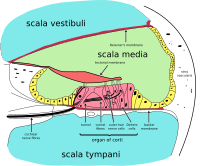
Photo from wikipedia
BACKGROUND The overall genetic profile for noise-induced hearing loss (NIHL) remains elusive. Herein we proposed a novel machine learning (ML) based strategy to evaluate individual susceptibility to NIHL and identify… Click to show full abstract
BACKGROUND The overall genetic profile for noise-induced hearing loss (NIHL) remains elusive. Herein we proposed a novel machine learning (ML) based strategy to evaluate individual susceptibility to NIHL and identify the underlying genetic risk variants based on a subsample of participants with extreme phenotypes. METHODS Five features (age, sex, cumulative noise exposure [CNE], smoking, and alcohol drinking status) of 5,539 shipbuilding workers from large cross-sectional surveys were included in four ML classification models to predict their hearing levels. The area under the curve (AUC) and prediction accuracy were exploited to evaluate the performance of the models. Based on the prediction error of the ML models, the NIHL-susceptible group (n=150) and NIHL-resistant group (n=150) with a paradoxical relationship between hearing levels and features were separately screened, to identify the underlying variants associated with NIHL risk using whole-exome sequencing (WES). Subsequently, candidate risk variants were validated in an additional replication cohort (n=2108), followed by a meta-analysis. RESULTS With 10-fold cross-validation, the performances of the four ML models were robust and similar, with average AUCs and accuracies ranging from 0.783 to 0.798 and 73.7% to 73.8%, respectively. The phenotypes of the NIHL-susceptible and NIHL-resistant groups were significantly different (all p<0.001). After WES analysis and filtering, 12 risk variants contributing to NIHL susceptibility were identified and replicated. The meta-analyses showed that the A allele of CDH23 rs41281334 (odds ratio [OR]=1.506, 95% confidence interval [CI]=1.106-2.051) and the C allele of WHRN rs12339210 (OR=3.06, 95% CI=1.398-6.700) were significantly associated with increased risk of NIHL after adjustment for confounding factors. CONCLUSIONS This study revealed two genetic variants in CDH23 rs41281334 and WHRN rs12339210 that associated with NIHL risk, based on a promising approach for evaluating individual susceptibility using ML models.
Journal Title: Hearing Research
Year Published: 2021
Link to full text (if available)
Share on Social Media: Sign Up to like & get
recommendations!